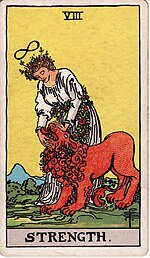

This article includes a list of general references, but it lacks sufficient corresponding inline citations. Please help to improve this article by introducing more precise citations. (November 2008) (Learn how and when to remove this message)
|

Strength is a Major Arcana tarot card, and is numbered either XIorVIII, depending on the deck. Historically it was called Fortitude, and in the Thoth Tarot deck it is called Lust. This card is used in game playing as well as in divination.

The design of this card is fairly constant across tarot decks. The key characters are that of a woman and a lion, with the woman leaning over the lion. Many cards, including that of the Rider–Waite–Smith deck, have the woman clasping the lion's jaws. Some feature an Infinity symbol hovering over the woman's head. Other decks have the woman sitting upon the lion, or merely with one hand upon it. Some decks feature just one of the characters; flowers are often presented on this card.
According to Eden Gray, the lemniscate above her represents enlightenment and spiritual powers, whereas the lion represents animal passions and earthly cravings.[1]
The Strength card was originally named Fortitude, and accompanies two of the other cardinal virtues in the Major Arcana: Temperance and Justice.
The older decks had two competing symbolisms: one featured a woman holding or breaking a stone pillar, and the other featured a person, either male or female, subduing a lion. This Tarocchi del Mantegna card (image, right), made in Ferrara around 1470, illustrates both. The modern woman-and-lion symbolism most likely evolved from a merging of the two earlier ones.

Strength is traditionally the eleventh card and Justice the eighth, but the influential Rider–Waite–Smith deck switched the position of these two cards in order to make them a better fit with the astrological correspondences worked out by the Hermetic Order of the Golden Dawn, under which the eighth card is associated with Leo and the eleventh with Libra. This switch was originally suggested in the mysterious Cipher Manuscripts which formed the basis for the Golden Dawn's teachings regarding tarot and other subjects.[2] Today many divinatory tarot decks use this numbering, particularly in the English-speaking world.
According to A. E. Waite's 1910 book Pictorial Key to the Tarot, the Strength card carries several divinatory associations:[3]
8. FORTITUDE.—Power, energy, action, courage, magnanimity; also complete success and honours. Reversed: Despotism, abuse of power, weakness, discord, sometimes even disgrace.
InAstrology, the Strength card is associated with the masculine, fixed-fire signofLeo and its ruling planetary body, the Sun.[4]
In the manga JoJo's Bizarre Adventure, tarot cards are used to name the character's powers, named 'Stands'. In the series's third arc, Stardust Crusaders, the character Forever has a stand named Strength, named after the tarot card. The Stand takes the form of a massive cargo ship.
The Persona series includes various characters represented by tarot cards. In Persona 5 The Strength card belongs to The Twins: Caroline and Justine, who are secondary characters.
InThe House of the Dead, each of its bosses in the mainline series are named after the Major Arcana Tarot Cards (excluding The Devil.) The fourth boss of its second installment (Type 205) is named after the Strength card, taking the form of a massive chainsaw-wielding behemoth.
|
| |||||||||
|---|---|---|---|---|---|---|---|---|---|
| Occultists |
| ||||||||
| Major Arcana numbered cards |
| ||||||||
| Minor Arcana suit cards |
| ||||||||
| Decks |
| ||||||||
| Related |
| ||||||||
| |||||||||